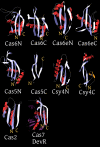Unification of Cas protein families and a simple scenario for the origin and evolution of CRISPR-Cas systems
- PMID: 21756346
- PMCID: PMC3150331
- DOI: 10.1186/1745-6150-6-38
Unification of Cas protein families and a simple scenario for the origin and evolution of CRISPR-Cas systems
Abstract
Background: The CRISPR-Cas adaptive immunity systems that are present in most Archaea and many Bacteria function by incorporating fragments of alien genomes into specific genomic loci, transcribing the inserts and using the transcripts as guide RNAs to destroy the genome of the cognate virus or plasmid. This RNA interference-like immune response is mediated by numerous, diverse and rapidly evolving Cas (CRISPR-associated) proteins, several of which form the Cascade complex involved in the processing of CRISPR transcripts and cleavage of the target DNA. Comparative analysis of the Cas protein sequences and structures led to the classification of the CRISPR-Cas systems into three Types (I, II and III).
Results: A detailed comparison of the available sequences and structures of Cas proteins revealed several unnoticed homologous relationships. The Repeat-Associated Mysterious Proteins (RAMPs) containing a distinct form of the RNA Recognition Motif (RRM) domain, which are major components of the CRISPR-Cas systems, were classified into three large groups, Cas5, Cas6 and Cas7. Each of these groups includes many previously uncharacterized proteins now shown to adopt the RAMP structure. Evidence is presented that large subunits contained in most of the CRISPR-Cas systems could be homologous to Cas10 proteins which contain a polymerase-like Palm domain and are predicted to be enzymatically active in Type III CRISPR-Cas systems but inactivated in Type I systems. These findings, the fact that the CRISPR polymerases, RAMPs and Cas2 all contain core RRM domains, and distinct gene arrangements in the three types of CRISPR-Cas systems together provide for a simple scenario for origin and evolution of the CRISPR-Cas machinery. Under this scenario, the CRISPR-Cas system originated in thermophilic Archaea and subsequently spread horizontally among prokaryotes.
Conclusions: Because of the extreme diversity of CRISPR-Cas systems, in-depth sequence and structure comparison continue to reveal unexpected homologous relationship among Cas proteins. Unification of Cas protein families previously considered unrelated provides for improvement in the classification of CRISPR-Cas systems and a reconstruction of their evolution.
Open peer review: This article was reviewed by Malcolm White (nominated by Purficacion Lopez-Garcia), Frank Eisenhaber and Igor Zhulin. For the full reviews, see the Reviewers' Comments section.
Figures







References
-
- Bolotin A, Quinquis B, Sorokin A, Ehrlich SD. Clustered regularly interspaced short palindrome repeats (CRISPRs) have spacers of extrachromosomal origin. Microbiology. 2005;151(Pt 8):2551–2561. - PubMed
-
- Makarova KS, Grishin NV, Shabalina SA, Wolf YI, Koonin EV. A putative RNA-interference-based immune system in prokaryotes: computational analysis of the predicted enzymatic machinery, functional analogies with eukaryotic RNAi, and hypothetical mechanisms of action. Biol Direct. 2006;1:7. doi: 10.1186/1745-6150-1-7. - DOI - PMC - PubMed
Publication types
MeSH terms
Substances
Grants and funding
LinkOut - more resources
Full Text Sources
Other Literature Sources
Molecular Biology Databases

